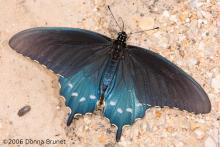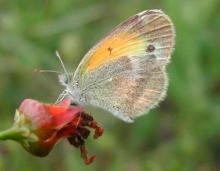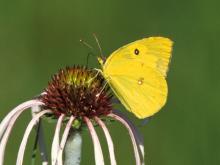Butterflies and Moths
Media

Species Types
Scientific Name
Battus philenor
Description
The pipevine swallowtail is ignored by most predators because of its acrid body juices. Several other butterflies benefit by looking strikingly similar.
Media

Species Types
Scientific Name
Pterourus troilus
Description
Spicebush swallowtails are beautiful large black butterflies with beautiful iridescent blue-green on the hindwings. The caterpillars eat the leaves of sassafras and spicebush.
Media

Species Types
Scientific Name
Pieris rapae
Description
A common butterfly in Missouri, the cabbage white was introduced in the 1800s from Europe and became a crop pest.
Media

Species Types
Scientific Name
Pontia protodice
Description
The checkered white is named for the charcoal-colored patterns on the white wings of adults. As with the closely related cabbage white, the larvae feed on plants in the mustard family.
Media

Species Types
Scientific Name
Colias philodice
Description
The clouded sulphur is one of our most common butterflies, flying low over fields and lawns, from late March into December.
Media

Species Types
Scientific Name
Phoebis sennae
Description
The cloudless sulphur is the large, clear-yellow butterfly you see flying rapidly to the southward in late summer and fall: They’re migrating!
Media

Species Types
Scientific Name
Nathalis iole
Description
Each year, dainty sulphurs arrive in Missouri from regions to our south. They are small compared to other sulphur butterflies. The wingspan of the largest individuals reaches only about 1¼ inches.
Media

Species Types
Scientific Name
Pyrisitia lisa (syn. Eurema lisa)
Description
The little yellow is just what the name says it is. The lower side is yellow with a few spots, including two tiny black spots on the basal hindwing and, often, a larger rusty spot on the hindwing margin.
Media

Species Types
Scientific Name
Colias eurytheme
Description
One of the most common butterflies in Missouri, the orange sulphur often gathers in numbers in moist places.
Media

Species Types
Scientific Name
Zerene cesonia (formerly Colias cesonia)
Description
The southern dogface has a dog’s head pictured on its yellow forewings. It repopulates our state each year from the south.
See Also


Media

Species Types
Scientific Name
About 1,500 species in North America north of Mexico
Description
Adult caddisflies are mothlike. Their larvae are aquatic and build portable, protective cases out of local materials, including grains of sand, bits of leaves and twigs, and other debris.
Media

Species Types
Scientific Name
Corydalus cornutus
Description
Adult eastern dobsonflies are huge and mothlike, with large wings and a weak, fluttery flight. The fiercely predaceous aquatic larvae, called hellgrammites, are well-known to anglers, who often use them as bait.
About Butterflies and Moths in Missouri
Butterflies, skippers, and moths belong to an insect order called the Lepidoptera — the "scale-winged" insects. These living jewels have tiny, overlapping scales that cover their wings like shingles. The scales, whether muted or colorful, seem dusty if they rub off on your fingers. Many butterflies and moths are associated with particular types of food plants, which their caterpillars must eat in order to survive.





















